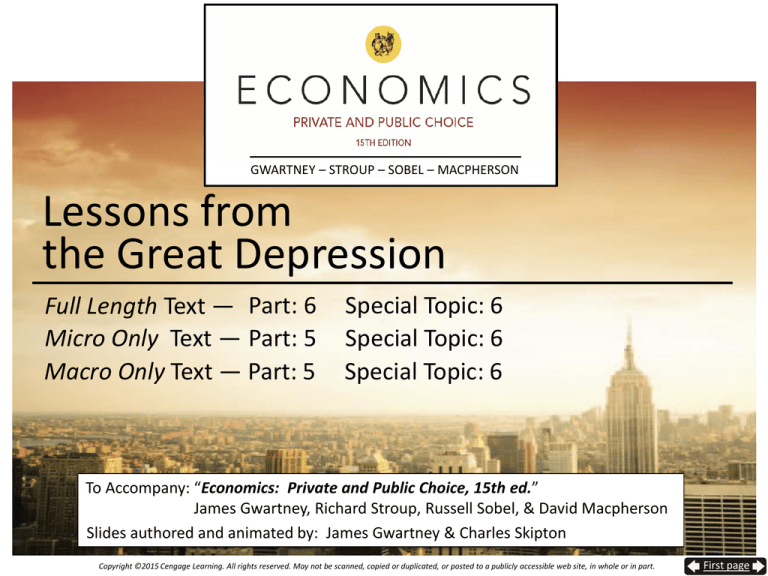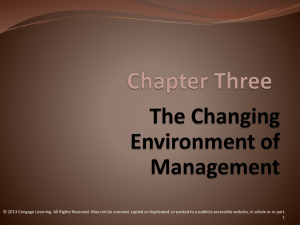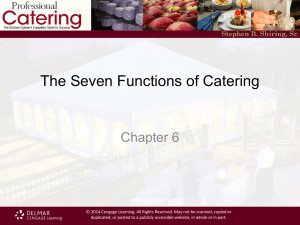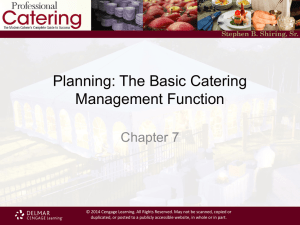
GWARTNEY – STROUP – SOBEL – MACPHERSON
Lessons from
the Great Depression
Full Length Text — Part: 6
Micro Only Text — Part: 5
Macro Only Text — Part: 5
Special Topic: 6
Special Topic: 6
Special Topic: 6
To Accompany: “Economics: Private and Public Choice, 15th ed.”
James Gwartney, Richard Stroup, Russell Sobel, & David Macpherson
Slides authored and animated by: James Gwartney & Charles Skipton
Copyright ©2015 Cengage Learning. All rights reserved. May not be scanned, copied or duplicated, or posted to a publicly accessible web site, in whole or in part.
First page
The Economic Record
of the Great Depression
15th
edition
Gwartney-Stroup
Sobel-Macpherson
Copyright ©2015 Cengage Learning. All rights reserved. May not be scanned, copied or duplicated, or posted to a publicly accessible web site, in whole or in part.
First page
15th
Conditions During the Great Depression
•
•
•
•
•
edition
Gwartney-Stroup
Sobel-Macpherson
Large reductions in output
Soaring unemployment
Farm and home foreclosures
Bank failures
Human suffering
Copyright ©2015 Cengage Learning. All rights reserved. May not be scanned, copied or duplicated, or posted to a publicly accessible web site, in whole or in part.
First page
15th
edition
Real GDP, 1929-1940
Gwartney-Stroup
Sobel-Macpherson
Real GDP Growth (%)
1929-1940
13.0
10.9
•Real GDP plunged during
1929-1933
•After a modest recovery
during 1934-1936, real GDP
fell again in 1938.
8.9
8.1 8.8
5.1
4.0
- 1.3
- 3.4
- 6.5
- 8.6
- 13.1
1929 1930 1931 1932 1933 1934 1935 1936 1937 1938 1939 1940
Copyright ©2015 Cengage Learning. All rights reserved. May not be scanned, copied or duplicated, or posted to a publicly accessible web site, in whole or in part.
First page
15th
edition
Rate of Unemployment, 1929-1940
•The rate of unemployment
rose from 3.2% in 1929 to 8.7%
in 1930 and 15.9% in 1931.
•In 1932-1933, unemployment
soared to nearly one-quarter
of the labor force.
•After declining to 14.3% in
1937, unemployment rose to
19% in 1938 and it stood at
17% in 1939 – a decade after
the catastrophic decline began
Gwartney-Stroup
Sobel-Macpherson
Unemployment Rate (%)
1929-1940
23.6
15.9
24.9
21.7
20.1
19.0
16.9
14.3
17.2
14.6
8.7
3.2
1929 1930 1931 1932 1933 1934 1935 1936 1937 1938 1939 1940
Copyright ©2015 Cengage Learning. All rights reserved. May not be scanned, copied or duplicated, or posted to a publicly accessible web site, in whole or in part.
First page
15th
The Great Depression
edition
Gwartney-Stroup
Sobel-Macpherson
• The Great Depression was a time of high
unemployment, soup lines, and banking panics
Copyright ©2015 Cengage Learning. All rights reserved. May not be scanned, copied or duplicated, or posted to a publicly accessible web site, in whole or in part.
First page
Was the Great Depression Caused
by the 1929 Stock Market Crash?
15th
edition
Gwartney-Stroup
Sobel-Macpherson
Copyright ©2015 Cengage Learning. All rights reserved. May not be scanned, copied or duplicated, or posted to a publicly accessible web site, in whole or in part.
First page
15th
edition
Stock Market, 1928-1930
•Stock prices plunged in
September-October 1929
•They recovered during
the five months from
mid-November 1929
through mid-April 1930.
•However, they continued
on a downward path
during May and for
the rest of 1930. Why?
Gwartney-Stroup
Sobel-Macpherson
Dow Jones Industrial Average
1928-1930
400
Smoot-Hawley
debated & passed
300
200
100
Jan-28
Jul 28
Jn-29
Jul29
Jan-30
Copyright ©2015 Cengage Learning. All rights reserved. May not be scanned, copied or duplicated, or posted to a publicly accessible web site, in whole or in part.
Jul-30
First page
15th
edition
Stock Market, 1931-1940
Gwartney-Stroup
Sobel-Macpherson
Dow Jones Industrial Average
1931-1940
400
•The Dow continued to fall
throughout 1931 & 1932.
300
•There was a sharp rebound
in stock prices during 1933.
200
•Even so, the Dow never
reached 200 throughout
the remainder of the
decade.
100
1931
1932
1933
1934
1935
1936
1937
1938
1939
Copyright ©2015 Cengage Learning. All rights reserved. May not be scanned, copied or duplicated, or posted to a publicly accessible web site, in whole or in part.
1940
First page
15th
Stock Prices and Recessions
edition
Gwartney-Stroup
Sobel-Macpherson
• The 1929 decline in stock prices reduced wealth,
aggregate demand, and real output.
• Stock prices have fallen by 50% or more during other
recessions, but the economy still moved toward a
recovery within a year or two.
• While the decline in stock prices may have triggered the
initial economic decline, the length and severity of the
Great Depression were the result of other factors.
Copyright ©2015 Cengage Learning. All rights reserved. May not be scanned, copied or duplicated, or posted to a publicly accessible web site, in whole or in part.
First page
Why Was the Great Depression
So Lengthy and Severe?
15th
edition
Gwartney-Stroup
Sobel-Macpherson
Copyright ©2015 Cengage Learning. All rights reserved. May not be scanned, copied or duplicated, or posted to a publicly accessible web site, in whole or in part.
First page
15th
Causes of the Great Depression
edition
Gwartney-Stroup
Sobel-Macpherson
• The length and severity of the Great Depression were the
result of four major policy mistakes:
• Contraction in the money supply
• Large increase in tariffs
• Huge tax increases in 1932 and again in 1936
• Price controls, perverse regulations, and constant
policy changes during the New Deal era
Copyright ©2015 Cengage Learning. All rights reserved. May not be scanned, copied or duplicated, or posted to a publicly accessible web site, in whole or in part.
First page
Factor 1:
Contraction of the Money Supply
15th
edition
Gwartney-Stroup
Sobel-Macpherson
• The supply of money expanded slowly but steadily
throughout the 1920s.
• Even though prices were relatively stable in the 1920s,
the Fed increased the discount rate, four times between
January 1928 and August 1929, pushing it up from 3.5%
to 6%.
• After the October stock market crash, the Fed
aggressively sold government bonds, which drained
reserves from the banking system and reduced the
money supply.
Copyright ©2015 Cengage Learning. All rights reserved. May not be scanned, copied or duplicated, or posted to a publicly accessible web site, in whole or in part.
First page
15th
edition
Change in Money Supply, 1925-1940
•The money supply fell
by 3.9% during 1930,
by 15.3% in 1931, and
by 8.9% in 1932
•The quantity of money
at year-end 1933 was
33% less than in 1929.
•The money supply
increased during 19341937, but dipped again
in 1938.
Gwartney-Stroup
Sobel-Macpherson
Annual Change of M1 Money Supply (%)
1925-1940
13.8
15.9
7.7
4.5
12.5
11.5
10.0
5.9
3.6
0.0
- 1.5
- 2.2
- 3.9
- 8.9 - 9.5
- 15.3
Copyright ©2015 Cengage Learning. All rights reserved. May not be scanned, copied or duplicated, or posted to a publicly accessible web site, in whole or in part.
First page
15th
Change In Consumer Prices, 1925-1940
edition
Gwartney-Stroup
Sobel-Macpherson
Annual Change Consumer Price Index (%)
•Monetary contraction
during 1929-1933 led
to deflation
•The deflation changed
the terms of loans,
investments, and other
economic activities that
take place across time
periods
1925-1940
2.3
3.1
1.1
3.6
2.2
1.5
0.7
0.0
-1.7 -1.7
- 2.3
-2.1
-1.4
- 5.1
- 9.0
- 9.9
Copyright ©2015 Cengage Learning. All rights reserved. May not be scanned, copied or duplicated, or posted to a publicly accessible web site, in whole or in part.
First page
Monetary Policy
and the Great Depression
15th
edition
Gwartney-Stroup
Sobel-Macpherson
• Sound monetary policy is about monetary and price
stability.
• The Fed failed during the 1930s:
• The initial monetary contraction, during 1929-1933,
plunged the economy into recession, and,
• the 2nd monetary contraction, during 1937-1938,
stifled the prospects for recovery.
• The monetary instability of the 1930s generated
uncertainty and undermined the exchange process.
Copyright ©2015 Cengage Learning. All rights reserved. May not be scanned, copied or duplicated, or posted to a publicly accessible web site, in whole or in part.
First page
Factor 2:
Smoot-Hawley Tariff Increases of 1930
15th
edition
Gwartney-Stroup
Sobel-Macpherson
• The legislation for the Smoot-Hawley tariff, which passed
June 1930, increased tariffs by more than 50% on almost
3,200 imported products
• Like proponents of trade restrictions today, the SmootHawley supporters argued the bill would “save jobs”
• “I want to see American workers employed producing
American goods for American consumption”
– Rep. Willis Hawley.
Copyright ©2015 Cengage Learning. All rights reserved. May not be scanned, copied or duplicated, or posted to a publicly accessible web site, in whole or in part.
First page
Factor 2:
Smoot-Hawley Tariff Increases of 1930
15th
edition
Gwartney-Stroup
Sobel-Macpherson
• Recognizing the restrictions would reduce both trade
and output, more than 1,000 economists pleaded with
President Hoover to veto the bill; he rejected their
advice.
• The stock market, which had rebounded to levels prior
to the October 1929 crash, moved steadily downward
as Congress debated and passed the Smoot-Hawley bill.
• Sixty countries responded with higher tariffs on
American exports and the volume of trade fell by more
than 50%.
Copyright ©2015 Cengage Learning. All rights reserved. May not be scanned, copied or duplicated, or posted to a publicly accessible web site, in whole or in part.
First page
Factor 2:
Smoot-Hawley Tariff Increases of 1930
15th
edition
Gwartney-Stroup
Sobel-Macpherson
• Smoot-Hawley reduced the gains from specialization and
trade, generated less tariff revenue even though the
rates were higher, and plunged the economy further into
recession
• The unemployment rate was 7.8% when Smoot-Hawley
was passed, but it ballooned to 23.6% just two years
later
Copyright ©2015 Cengage Learning. All rights reserved. May not be scanned, copied or duplicated, or posted to a publicly accessible web site, in whole or in part.
First page
15th
Smoot- Hawley
edition
Gwartney-Stroup
Sobel-Macpherson
• Sen. Reid Smoot (R) and
Rep. Willis (L) Hawley thought
their tariff increases would
“save jobs.”
• Instead, the Smoot-Hawley
tariff of 1930 reduced output
and plunged the economy
deeper into recession.
Copyright ©2015 Cengage Learning. All rights reserved. May not be scanned, copied or duplicated, or posted to a publicly accessible web site, in whole or in part.
First page
Factor 3: Tax Increases in
the Midst of a Severe Downturn
15th
edition
Gwartney-Stroup
Sobel-Macpherson
• As the Federal budget fell into deficit in 1931, Congress
and the Hoover Administration instituted a huge tax
increase in order to balance the federal budget.
• This tax increase both reduced aggregate demand and
the incentive to earn and invest, plunging the economy
still deeper into recession
Copyright ©2015 Cengage Learning. All rights reserved. May not be scanned, copied or duplicated, or posted to a publicly accessible web site, in whole or in part.
First page
15th
Marginal Income Tax Rates, 1925-1940
•The top marginal
income tax rate was
increased from 25%
in 1931 to 63% in 1932
– other rates were
increased by a similar
amount.
•In 1932, real GDP fell
by 13.3% and the
unemployment rate
soared to nearly a
quarter of the labor
force.
edition
Gwartney-Stroup
Sobel-Macpherson
Top and Bottom Marginal Income Tax Rates (%)
90
1925-1940
80
70
60
50
40
30
20
10
0
1925 1926 1927 1928 1929 1930 1931 1932 1933 1934 1935 1936 1937 1938 1939 1940
Top Marginal Rate
Lowest Marginal Rate
Copyright ©2015 Cengage Learning. All rights reserved. May not be scanned, copied or duplicated, or posted to a publicly accessible web site, in whole or in part.
First page
15th
Marginal Income Tax Rates, 1925-1940
•The top marginal tax
rate was pushed still
higher to 79% in 1936,
and the tax on the
retained earnings
of business was also
sharply increased.
•These tax increases
contributed to the
recession of 19371938.
edition
Gwartney-Stroup
Sobel-Macpherson
Top and Bottom Marginal Income Tax Rates (%)
90
1925-1940
80
70
60
50
40
30
20
10
0
1925 1926 1927 1928 1929 1930 1931 1932 1933 1934 1935 1936 1937 1938 1939 1940
Top Marginal Rate
Lowest Marginal Rate
Copyright ©2015 Cengage Learning. All rights reserved. May not be scanned, copied or duplicated, or posted to a publicly accessible web site, in whole or in part.
First page
Factor 4: Price Controls, Regulations,
and Constant Policy Changes
15th
edition
Gwartney-Stroup
Sobel-Macpherson
• Many history books credit the New Deal policies with the
eventual end of the Great Depression
• Some New Deal policies were helpful:
• The Federal Deposit Insurance program
• Re-evaluation of gold and the expansion in the money
supply during 1934-1936
• But other policies were harmful, and increased the
length and severity of the Great Depression
Copyright ©2015 Cengage Learning. All rights reserved. May not be scanned, copied or duplicated, or posted to a publicly accessible web site, in whole or in part.
First page
15th
The Agricultural Adjustment Act (AAA)
edition
Gwartney-Stroup
Sobel-Macpherson
• Under the AAA, adopted in 1933, the Roosevelt
Administration tried to push prices up by restricting
supply.
• Farmers were paid to plow under portions of cotton,
corn, wheat, and other crops
• Potato Farmers were paid to spray their potatoes with
dye so they would be unfit for human consumption
• Cattle, sheep, and pigs were slaughtered
• AAA was declared unconstitutional in 1936.
Copyright ©2015 Cengage Learning. All rights reserved. May not be scanned, copied or duplicated, or posted to a publicly accessible web site, in whole or in part.
First page
15th
The Agricultural Adjustment Act (AAA)
edition
Gwartney-Stroup
Sobel-Macpherson
• In an effort to push farm
prices up, 6 million pigs
were slaughtered under
the AAA in 1933 alone.
Copyright ©2015 Cengage Learning. All rights reserved. May not be scanned, copied or duplicated, or posted to a publicly accessible web site, in whole or in part.
First page
15th
National Industrial Recovery Act (NIRA)
edition
Gwartney-Stroup
Sobel-Macpherson
• Under the National Industrial Recovery Act (NIRA)
legislation passed in June 1933:
• More than 500 industries ranging from automobiles
and steel to dog food and dry cleaners were organized
into cartels.
• Government and business leaders set production
quotas, prices, wages, working hours, and distribution
methods for each industry.
Copyright ©2015 Cengage Learning. All rights reserved. May not be scanned, copied or duplicated, or posted to a publicly accessible web site, in whole or in part.
First page
15th
National Industrial Recovery Act (NIRA)
edition
Gwartney-Stroup
Sobel-Macpherson
• Under the National Industrial Recovery Act (NIRA)
legislation passed in June 1933:
• Once approved by a majority of the firms, the
regulations were legally binding on all of the firms in
the industry
• Businesses that did not comply were fined and subject
to jail sentences
• Prior to this legislation, price fixing of this type would
have been a violation of anti-trust legislation
• All of this reduced competition, promoted monopoly
pricing, and undermined the market process
Copyright ©2015 Cengage Learning. All rights reserved. May not be scanned, copied or duplicated, or posted to a publicly accessible web site, in whole or in part.
First page
15th
NIRA-Industrial Production, 1932-1936
•During April-July 1933,
industrial output increased
sharply.
•In July 1933, NIRA was
implemented and industrial
output fell more than 25%
over the next 6 months.
•Output did not reach the
June 1933 level again until
after the NIRA was declared
unconstitutional in May
1935.
edition
Gwartney-Stroup
Sobel-Macpherson
U.S. Industrial Production (index)
1932-1936
125
NIRA passed
NIRA is declared
unconstitutional
100
75
50
1932
1933
1934
1935
1936
Copyright ©2015 Cengage Learning. All rights reserved. May not be scanned, copied or duplicated, or posted to a publicly accessible web site, in whole or in part.
First page
Did the New Deal Policies
End the Great Depression?
15th
edition
Gwartney-Stroup
Sobel-Macpherson
• Many history books argue this was the case, but the
evidence is inconsistent with this view.
• Prior to the Great Depression, recessions lasted only
1 or 2 years (3 years at the most) and recovery that
followed pushed income to new highs.
• The Great Depression was different
Copyright ©2015 Cengage Learning. All rights reserved. May not be scanned, copied or duplicated, or posted to a publicly accessible web site, in whole or in part.
First page
Did the New Deal Policies
End the Great Depression?
15th
edition
Gwartney-Stroup
Sobel-Macpherson
• In 1933, the monetary contraction was reversed and
there was evidence of a private sector recovery.
• But the NIRA, AAA and the 1936 tax increases dampened
productive activity.
• Also the second monetary contraction pushed the
economy into another recession within the depression.
Copyright ©2015 Cengage Learning. All rights reserved. May not be scanned, copied or duplicated, or posted to a publicly accessible web site, in whole or in part.
First page
Did the New Deal Policies
End the Great Depression?
15th
edition
Gwartney-Stroup
Sobel-Macpherson
• Constant policy changes of the New Deal Era generated
uncertainty and undermined recovery.
• The unemployment rate was 19% in 1938 and 17% in
1939, 7 years after the start of the New Deal.
• The Great Depression was eventually diminished by the
military build-up prior to World War II.
Copyright ©2015 Cengage Learning. All rights reserved. May not be scanned, copied or duplicated, or posted to a publicly accessible web site, in whole or in part.
First page
Fiscal Policy During
the Great Depression
15th
edition
Gwartney-Stroup
Sobel-Macpherson
Copyright ©2015 Cengage Learning. All rights reserved. May not be scanned, copied or duplicated, or posted to a publicly accessible web site, in whole or in part.
First page
Fiscal Policy During
the Great Depression
15th
edition
Gwartney-Stroup
Sobel-Macpherson
• Prior to the Keynesian Revolution, the view that the
Federal Budget should be balanced was widely accepted.
• Both the Hoover and Roosevelt Administrations raised
taxes in an effort to reduce the size of the budget deficit.
• Many Keynesian economists argued that prior to World
War II the budget deficits were too small to provide
sufficient demand stimulus.
Copyright ©2015 Cengage Learning. All rights reserved. May not be scanned, copied or duplicated, or posted to a publicly accessible web site, in whole or in part.
First page
15th
Government Expenditures, 1929-1940
•Government spending as a
share of the economy was
small during the 1930s
18
•Total govt. spending
(federal, state, and local)
increased from 8% of GDP
in 1929 to 16% in 1933.
12
•After 1933, govt. spending
fluctuated around 15% the
remainder of the decade.
edition
Gwartney-Stroup
Sobel-Macpherson
Government Expenditures as a Share of GDP (%)
1929-1940
16
14
10
8
6
4
2
0
1929
1930 1931 1932
1933 1934 1935 1936 1937 1938
Federal
1939 1940
Total
Copyright ©2015 Cengage Learning. All rights reserved. May not be scanned, copied or duplicated, or posted to a publicly accessible web site, in whole or in part.
First page
15th
edition
Federal Budget Deficits, 1929-1940
Gwartney-Stroup
Sobel-Macpherson
Federal Budget Deficit (-) and
Surplus (+) as a Share of GDP (%)
1929-1940
•The Federal budget was in
surplus in 1929 and 1930.
•Except for 1934 and 1936,
Federal deficits in the 1930s
fluctuated around 2% of GDP.
1.1
0.2
0.2
-0.3
- 1.4
- 2.7
- 1.5
- 2.4
-2.3
-2.6
-3.2
-3.8
1929 1930 1931 1932 1933 1934 1935 1936 1937 1938 1939 1940
Copyright ©2015 Cengage Learning. All rights reserved. May not be scanned, copied or duplicated, or posted to a publicly accessible web site, in whole or in part.
First page
Lessons From
the Great Depression
15th
edition
Gwartney-Stroup
Sobel-Macpherson
Copyright ©2015 Cengage Learning. All rights reserved. May not be scanned, copied or duplicated, or posted to a publicly accessible web site, in whole or in part.
First page
What Are the Lessons
from the Great Depression?
15th
edition
Gwartney-Stroup
Sobel-Macpherson
• Monetary contraction will undermine economic activity
such as investment and thereby retard output and
employment.
• Trade restrictions will reduce the gains from
specialization and exchange.
• They will not save domestic jobs
• Instead they will lead to inefficient use
of resources and reductions in output
Copyright ©2015 Cengage Learning. All rights reserved. May not be scanned, copied or duplicated, or posted to a publicly accessible web site, in whole or in part.
First page
What Are the Lessons
from the Great Depression?
15th
edition
Gwartney-Stroup
Sobel-Macpherson
• Raising taxes during a recession will reduce output
and make matters worse.
• Constant policy changes will generate uncertainty, retard
private investment, reduce business activity, and thereby
prolong the depressed conditions.
Copyright ©2015 Cengage Learning. All rights reserved. May not be scanned, copied or duplicated, or posted to a publicly accessible web site, in whole or in part.
First page
What Are the Lessons
from the Great Depression?
15th
edition
Gwartney-Stroup
Sobel-Macpherson
• Good intentions are no substitute for sound policies.
• Key decision-makers such as Presidents Hoover and
Roosevelt, Sen. Smoot, Rep. Hawley, other members
of congress, and the monetary policy-makers of the
1930s had good intentions, but their actions tragically
turned what would have been a recession into the
Great Depression.
Copyright ©2015 Cengage Learning. All rights reserved. May not be scanned, copied or duplicated, or posted to a publicly accessible web site, in whole or in part.
First page
15th
Questions for Thought:
edition
Gwartney-Stroup
Sobel-Macpherson
1. Was the Great Depression caused by the 1929 stock
market crash?
2. Did the New Deal policies bring the Great Depression to
an end? Why or Why not?
3. What are the most important lessons Americans should
learn from the Great Depression? Do you think we have
learned them?
Copyright ©2015 Cengage Learning. All rights reserved. May not be scanned, copied or duplicated, or posted to a publicly accessible web site, in whole or in part.
First page
End of
Special Topic 6
Copyright ©2015 Cengage Learning. All rights reserved. May not be scanned, copied or duplicated, or posted to a publicly accessible web site, in whole or in part.
First page








